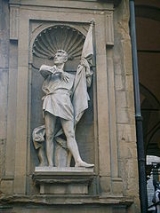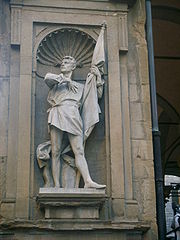
Ciompi
Encyclopedia
The Revolt of the Ciompi was a popular revolt in late medieval Florence
by wool carder
s known as ciompi (ˈtʃompi), who rose up in 1378 to demand a voice in the commune's ordering.
In late medieval Florence
, the disenfranchised ciompi ("wool carders") were a class of labourers in the textile
industry who were not represented by any guild
. The ciompi were among the most radical of the lower-class groups, vegetable sellers and crockery vendors and the like, and resented the controlling power that was centred in the Arte della Lana
, the textile-manufacturing establishment which guided the economic engine of Florence's prosperity, and was supported by the other major Guilds of Florence
, the Arti maggiori.
 In 1378, ciompi launched the Revolt of the Ciompi, a briefly successful insurrection of the disenfranchised lower classes, the popolo minuto, which remained as a traumatic memory for members of the major guild
In 1378, ciompi launched the Revolt of the Ciompi, a briefly successful insurrection of the disenfranchised lower classes, the popolo minuto, which remained as a traumatic memory for members of the major guild
s and contributed to the support given to the Medici
a generation afterwards, as stabilizers of Florentine order. The revolt briefly brought to power in 14th-century Florence an unprecedented level of democracy. The ciompi were defeated by the more conservative elements in Florentine society when the major and minor guilds closed ranks to re-establish the old order, a counter-revolution in which the knight Salvestro de' Medici
played a prominent role.
In June 1378, the unguilded wool-workers took up arms and attacked government buildings. On July 22, the lower classes forcibly took over the government, placing the wool carder Michele di Lando
in the executive office of gonfaloniere of justice
, and showing their banner at the Palazzo della Signoria.They compelled the governing body, the Signoria
, to establish additional guilds in order to grant the ciompi access to political office. During the time of ciompi control, they demanded the right to elect three of their own priors, the reduction of judicial corporal punishment, and reform the tax system.
Conflicts between the traditional guilds and the ciompi became evident. On August 31, a large group of the ciompi that had gathered in the Piazza della Signoria
were attacked by forces of the major and minor guilds led by the guild of butchers. In reaction to this revolutionary episode, the new ciompi guilds were abolished, and within four years the dominance of the major guilds was restored. By 1382, all the reforms that the ciompi had introduced had officially been eliminated.
The event was a traumatic episode for the Florentine upper classes. More than a century later, Niccolò Machiavelli
's Florentine Histories
depicts the revolt with a series of invented debates and speeches that reflect the positions of the protagonists, seen from the patrician point-of-view of a later champion of state stability. As might be expected, the sculpture of the popular leader Michele di Lando (illustration, right) was not placed in a niche on the facade of the loggia in the Mercato Nuovo
until the late nineteenth century, by which time historians of the Romantic generation
had recast him as a leader of the people.
Popular revolt in late medieval Europe
Popular revolts in late medieval Europe were uprisings and rebellions by peasants in the countryside, or the bourgeois in towns, against nobles, abbots and kings during the upheavals of the 14th through early 16th centuries, part of a larger "Crisis of the Late Middle Ages"...
by wool carder
Carding
Carding is a mechanical process that breaks up locks and unorganised clumps of fibre and then aligns the individual fibres so that they are more or less parallel with each other. The word is derived from the Latin carduus meaning teasel, as dried vegetable teasels were first used to comb the raw wool...
s known as ciompi (ˈtʃompi), who rose up in 1378 to demand a voice in the commune's ordering.
In late medieval Florence
Florence
Florence is the capital city of the Italian region of Tuscany and of the province of Florence. It is the most populous city in Tuscany, with approximately 370,000 inhabitants, expanding to over 1.5 million in the metropolitan area....
, the disenfranchised ciompi ("wool carders") were a class of labourers in the textile
Textile
A textile or cloth is a flexible woven material consisting of a network of natural or artificial fibres often referred to as thread or yarn. Yarn is produced by spinning raw fibres of wool, flax, cotton, or other material to produce long strands...
industry who were not represented by any guild
Guild
A guild is an association of craftsmen in a particular trade. The earliest types of guild were formed as confraternities of workers. They were organized in a manner something between a trade union, a cartel, and a secret society...
. The ciompi were among the most radical of the lower-class groups, vegetable sellers and crockery vendors and the like, and resented the controlling power that was centred in the Arte della Lana
Arte della Lana
The Arte della Lana was the wool guild of Florence during the Late Middle Ages and in the Renaissance. It was one of the seven greater Arti of Florence, separate from the Arti Minori...
, the textile-manufacturing establishment which guided the economic engine of Florence's prosperity, and was supported by the other major Guilds of Florence
Guilds of Florence
The guilds of Florence were secular corporations that controlled the arts and trades in Florence from the twelfth into the sixteenth century. These Arti included seven major guilds , five middle guilds and nine minor guilds...
, the Arti maggiori.
Revolt of the Ciompi

Guild
A guild is an association of craftsmen in a particular trade. The earliest types of guild were formed as confraternities of workers. They were organized in a manner something between a trade union, a cartel, and a secret society...
s and contributed to the support given to the Medici
Medici
The House of Medici or Famiglia de' Medici was a political dynasty, banking family and later royal house that first began to gather prominence under Cosimo de' Medici in the Republic of Florence during the late 14th century. The family originated in the Mugello region of the Tuscan countryside,...
a generation afterwards, as stabilizers of Florentine order. The revolt briefly brought to power in 14th-century Florence an unprecedented level of democracy. The ciompi were defeated by the more conservative elements in Florentine society when the major and minor guilds closed ranks to re-establish the old order, a counter-revolution in which the knight Salvestro de' Medici
Salvestro de' Medici
Salvestro di Alammano de' Medici was a former Gonfaloniere and Provost of the city of Florence.Salvestro was a member of the patrician class and an adversary of the noble Guelphic faction, who had been pursuing a policy of attempting to exclude the lesser guilds through admonitions.Salvestro was...
played a prominent role.
In June 1378, the unguilded wool-workers took up arms and attacked government buildings. On July 22, the lower classes forcibly took over the government, placing the wool carder Michele di Lando
Michele di Lando
Michele di Lando was the first leader of the Ciompi Revolt in Florence that started in 1378.-Background:Michele di Lando was the son of a woman named Simona who was a vegetable seller in Florence. Michele himself was a wool carder....
in the executive office of gonfaloniere of justice
Gonfaloniere of Justice
Gonfaloniere of Justice was a post in the government of medieval and early Renaissance Florence. Like Florence's Podestà and Priori, it was introduced in 1293 when Giano Della Bella's Ordinamenti di Giustizia came into force....
, and showing their banner at the Palazzo della Signoria.They compelled the governing body, the Signoria
Signoria of Florence
The Signoria was the government of medieval and renaissance Florence. Its nine members, the Priori, were chosen from the ranks of the guilds of the city: six of them from the major guilds, and two from the minor guilds...
, to establish additional guilds in order to grant the ciompi access to political office. During the time of ciompi control, they demanded the right to elect three of their own priors, the reduction of judicial corporal punishment, and reform the tax system.
Conflicts between the traditional guilds and the ciompi became evident. On August 31, a large group of the ciompi that had gathered in the Piazza della Signoria
Piazza della Signoria
Piazza della Signoria is an L-shaped square in front of the Palazzo Vecchio in Florence, Italy. It was named after the Palazzo della Signoria, also called Palazzo Vecchio....
were attacked by forces of the major and minor guilds led by the guild of butchers. In reaction to this revolutionary episode, the new ciompi guilds were abolished, and within four years the dominance of the major guilds was restored. By 1382, all the reforms that the ciompi had introduced had officially been eliminated.
The event was a traumatic episode for the Florentine upper classes. More than a century later, Niccolò Machiavelli
Niccolò Machiavelli
Niccolò di Bernardo dei Machiavelli was an Italian historian, philosopher, humanist, and writer based in Florence during the Renaissance. He is one of the main founders of modern political science. He was a diplomat, political philosopher, playwright, and a civil servant of the Florentine Republic...
's Florentine Histories
Florentine Histories
Florentine Histories is a historical account by Italian Renaissance political scientist and writer Niccolò Machiavelli, first published posthumously in 1532.-Background:...
depicts the revolt with a series of invented debates and speeches that reflect the positions of the protagonists, seen from the patrician point-of-view of a later champion of state stability. As might be expected, the sculpture of the popular leader Michele di Lando (illustration, right) was not placed in a niche on the facade of the loggia in the Mercato Nuovo
Loggia del Mercato Nuovo
The Loggia del Mercato Nuovo , popularly known as the Loggia del Porcellino , is a building in Florence, Italy. It is so called to distinguish it from the Mercato vecchio located in the area of today's Piazza della Repubblica....
until the late nineteenth century, by which time historians of the Romantic generation
Romanticism
Romanticism was an artistic, literary and intellectual movement that originated in the second half of the 18th century in Europe, and gained strength in reaction to the Industrial Revolution...
had recast him as a leader of the people.

